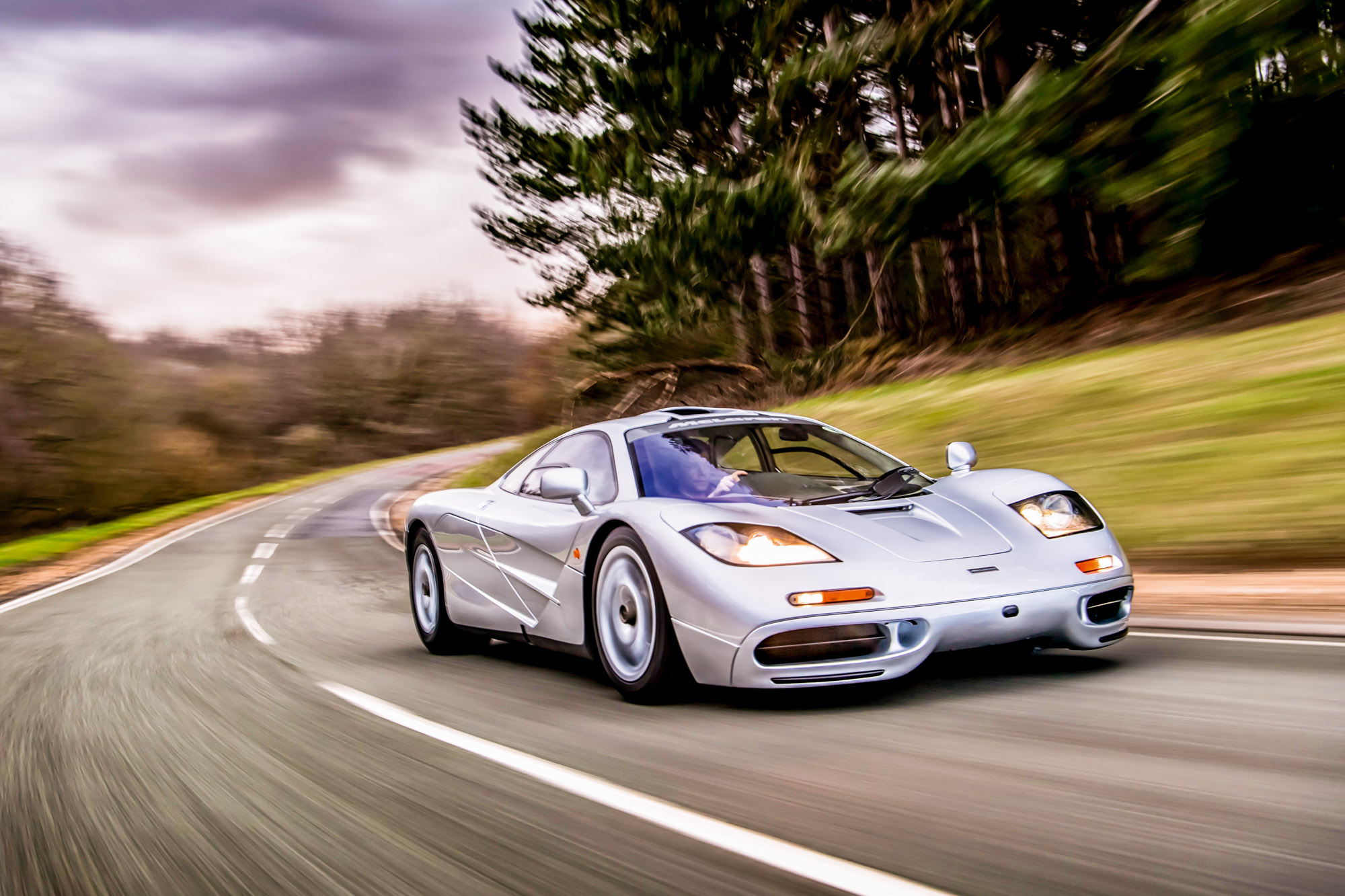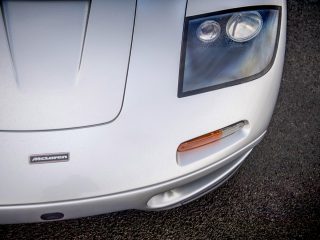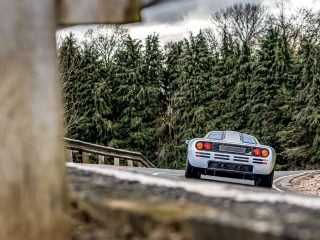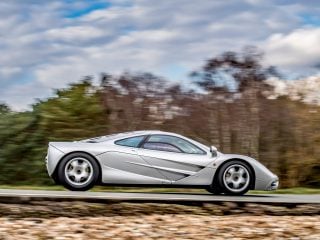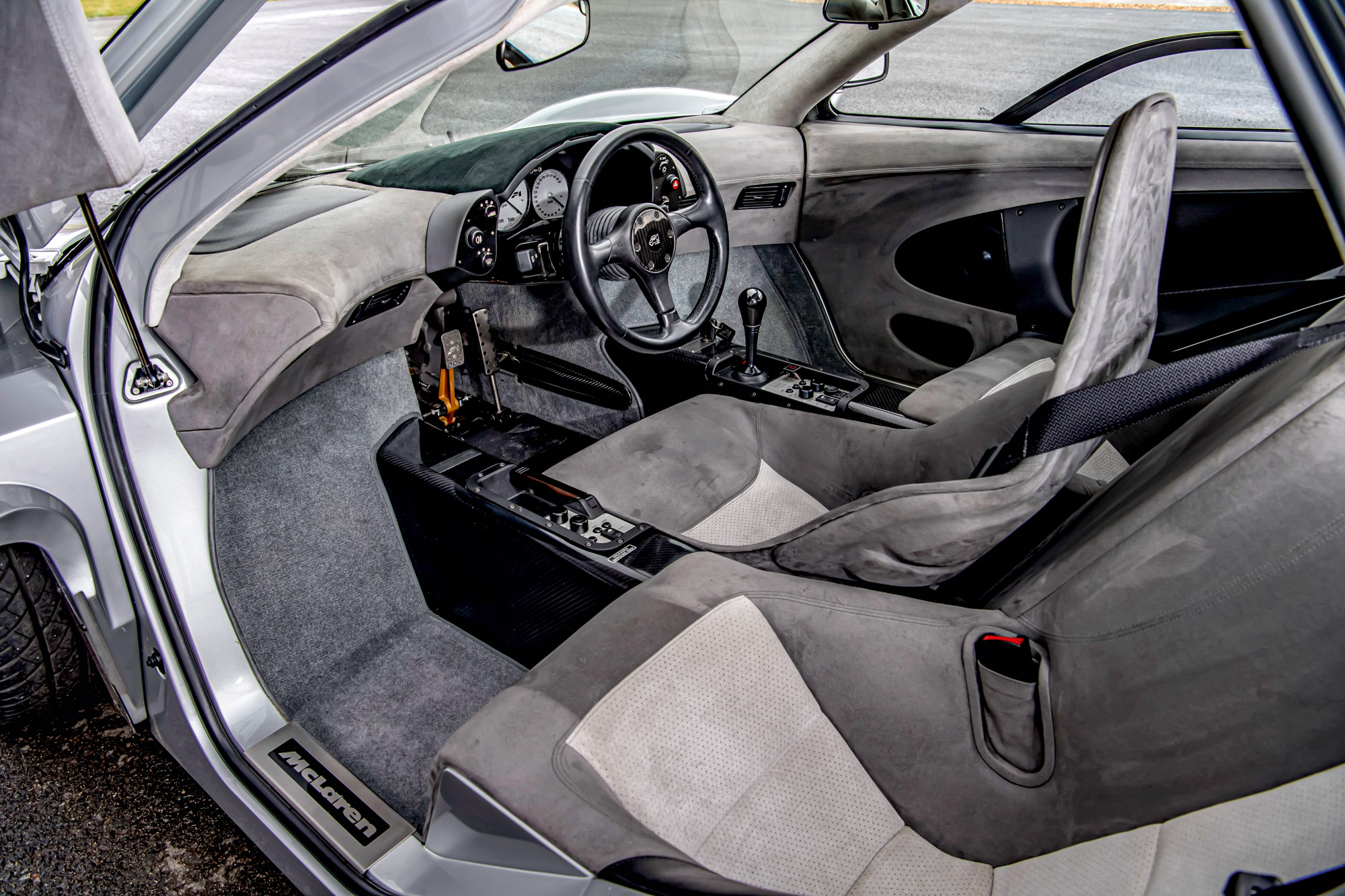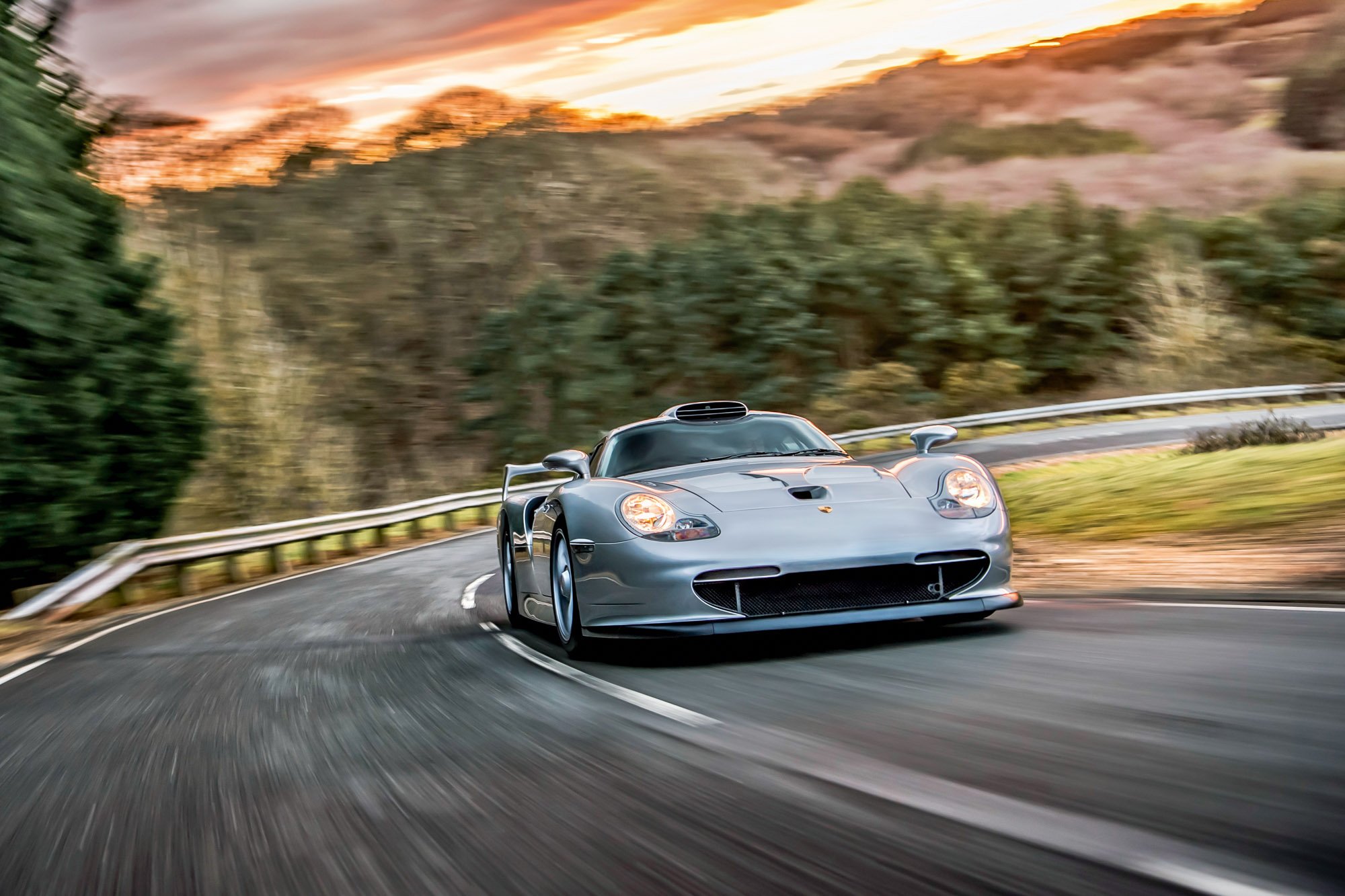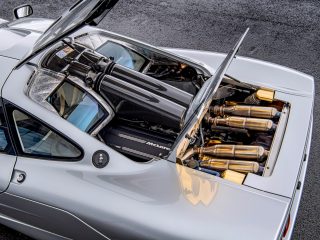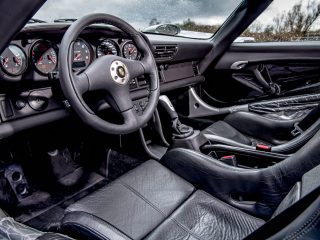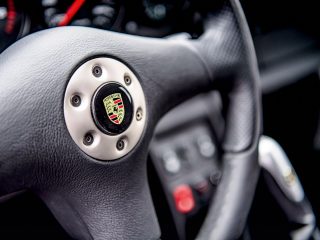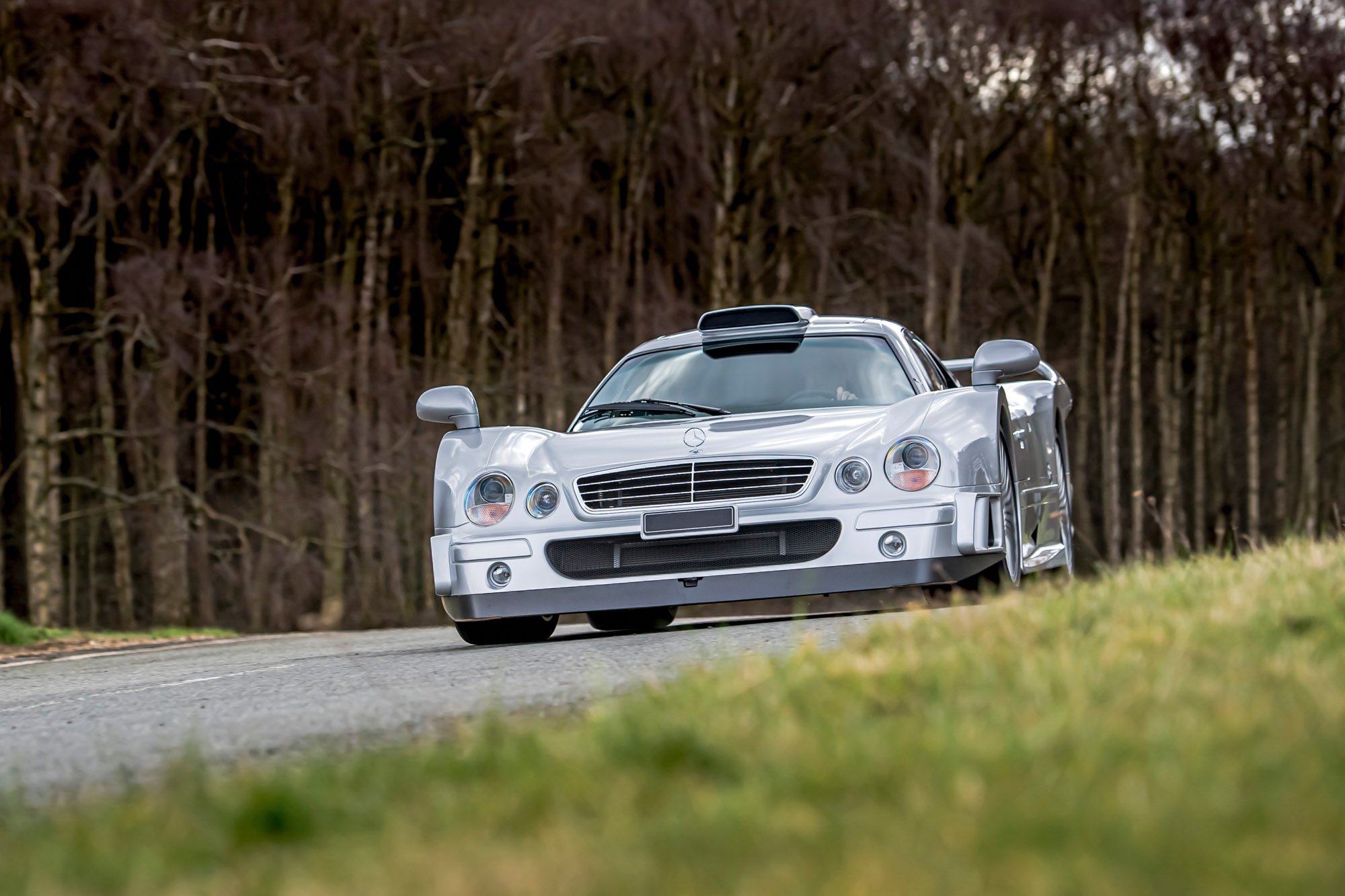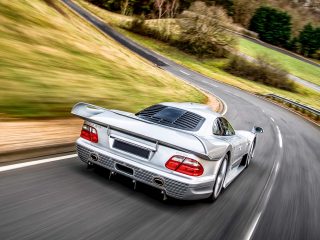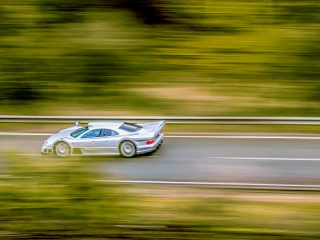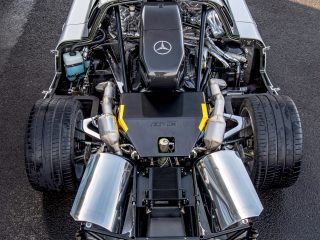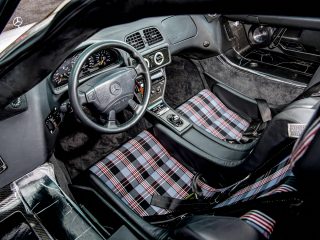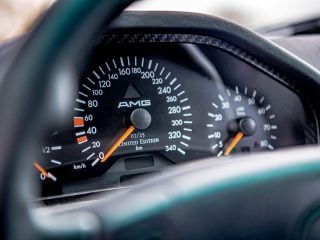This is the Holy Trinity, the cars that took on La Sarthe and were scarcely tamed for the road. Henry Catchpole braves the McLaren F1, Porsche 911 GT1 and Mercedes-AMG CLK GTR for Automotive Daily.
Photography by Andy Morgan
A down-change for the hell of it. Just to hear the V12. Because that dab provokes probably the best induction bark ever to emanate from a road car. There is almost a mirroring between the air rushing through the intake directly above your head, down to the engine behind you, and the tingles that start in your scalp and run down the length of your spine.
A glance right through the black arc that bisects the side window and there is the roof scoop of the wildest road car ever to be called a 911: the GT1. A glance left and there is the caricature face of the most expensive Mercedes road car ever made: the CLK GTR. I’m sitting in a McLaren F1 and yet I’m in the least rare car of our trio. By some margin. Not for the first time today, I find I can’t help but smile at the absurdity of what’s happening here.
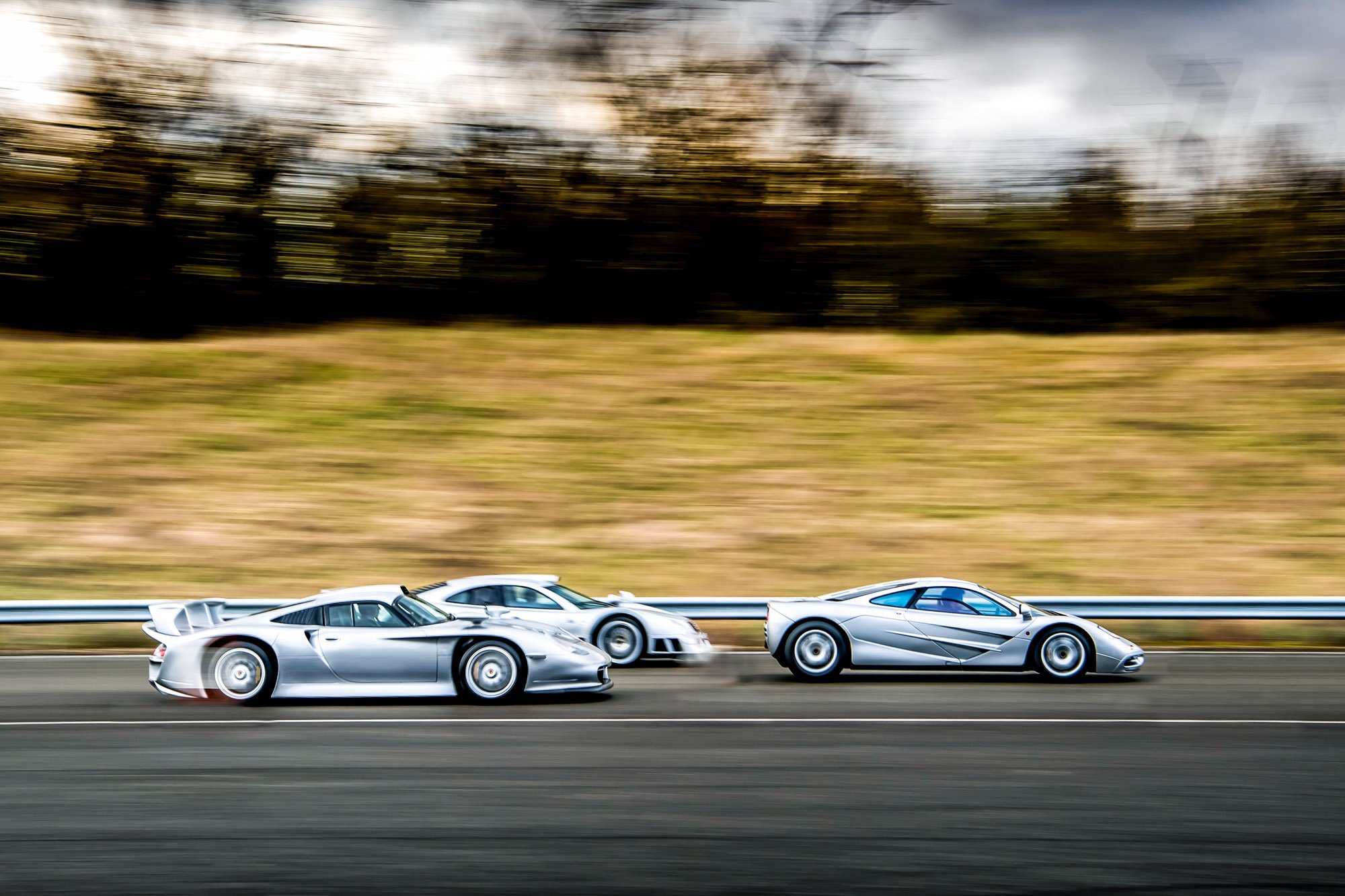 These are three of the most exciting road cars ever made, two developed from Le Mans racers, one conceived to be the greatest road car ever and which happened to win Le Mans. Outright! When James Cottingham from DK Engineering first asked me what the greatest trio of roadgoing sports cars could be, I instantly told him: these three. But actually getting them together? All right, I knew they had the GTR, but still. And that they should all be in silver makes this even more surreal. Here we have the story of a golden era of endurance racing. The GT1 racers and the incredible road cars they spawned are something that even today, with the new LMH category, the FIA is striving to recreate.
These are three of the most exciting road cars ever made, two developed from Le Mans racers, one conceived to be the greatest road car ever and which happened to win Le Mans. Outright! When James Cottingham from DK Engineering first asked me what the greatest trio of roadgoing sports cars could be, I instantly told him: these three. But actually getting them together? All right, I knew they had the GTR, but still. And that they should all be in silver makes this even more surreal. Here we have the story of a golden era of endurance racing. The GT1 racers and the incredible road cars they spawned are something that even today, with the new LMH category, the FIA is striving to recreate.
Famously the McLaren F1 was never intended to go racing. Gordon Murray and the team created a road car. And you can feel that as soon as you get into it. Granted, there is a convoluted technique (that I’ve yet to master) required if you want to get into an F1 as gracefully as you would a Ford Fiesta but, once ensconced, you can revel in a cockpit that feels all at once fantastically focused but also supremely spacious. Comfortable, too, despite the thin seat. You could imagine covering long distances in it. In fact, as the whole car is only 4288mm long and 1820mm wide, you could also happily conceive of popping into town.
1995 McLaren F1
Engine 6064cc V12, DOHC per bank, 48-valve, electronic fuel injection and engine management Power 468kW @ 7500rpm Torque 649Nm @ 4000-7000rpm Transmission Six-speed manual, rear-wheel drive, limited-slip differential Steering Rack and pinion Suspension Front and rear: double wishbones, alloy dampers, co-axial springs, anti-roll bar Brakes Discs, no servo assistance Weight 1137kg Top speed 386kph 0-100kph 3.3sec
Anyway, despite the obvious habitability of the F1, it was nonetheless created to exacting standards by a race team. As a performance road car, it had no equal at the time it was launched and so it was almost inevitable that, in a race series based on road cars, it would also be top of the tree. When customers convinced McLaren that a race car programme should be undertaken, it dominated the BPR Global GT Championship, winning both drivers’ and team titles in 1995 and 1996.
But it was the car’s victory, first time out, at Le Mans in 1995 that really put the cat among the pigeons. The victory may have been a little lucky, with the atrociously wet weather playing into the F1’s hands, but nonetheless it made the F1 GTR an instant icon.
Driving the F1 today remains an extraordinary experience. This, chassis 037, is the third F1 that I’ve been lucky enough to drive but these are such special cars that getting reacquainted isn’t the work of a moment. The 6.1-litre V12 dominates the experience because it is so responsive, so alive to every movement of the throttle. The power really is palpable and it’s intimidating. It takes quite a bit of courage to really extend the engine, partly because the gearshift has such a tight gate that for the first few miles there is a real concern about missing a shift across it as you go from second to third.
What’s more, in comparison to the whip-crack V12, the rest of the controls can feel a little slow in their responses. The steering is full of feel but also heavy, with very little inclination to naturally re-centre. The brakes are certainly not the most reassuring. Combine these with suspension that allows a lot of movement in terms of roll, squat and dive, and tyres that have plenty of sidewall to flex, and you can quickly find your hands very full. Brake hard, sense that delicate nose dip, add a bit of steering lock, feel the weight of the engine behind you and… well, you want to be very careful about what you do next with the throttle.
It’s a car that you need to be positive with, otherwise you can feel like it is in control of you, not the other way round. But you also need to be deft and in tune with the way it moves. I think it would be the most glorious car to own, because it would not only thrill you every time you cracked the throttle and felt the manifestation of that startling power-to-weight ratio, it would also be a constant learning experience. In the same way that you need time to master the weight-balance wiles of an old 911, so the McLaren is a car that you need more than a first date to get to know. Talking of 911s…
1997 Porsche 911 GT1 Evo Straßenversion
Engine 3164cc twin-turbo flat-six, DOHC per bank, 32-valve, electronic fuel injection and engine management Power 400kW @ 7200rpm Torque 601Nm @ 4250rpm Transmission Six-speed manual, rear-wheel drive, limited-slip differential Steering Rack and pinion, powerassisted Suspension Front and rear: double wishbones, pushrod-operated dampers, coil springs, anti-roll bar Brakes Discs, ABS Weight 1150kg Top speed 309kph 0-100kph 3.9sec
That win at La Sarthe in 1995 must have really annoyed Porsche. The 24-hours was its playground. So, for 1996, Norbert Singer was tasked with producing a car that was based on a 911 road car but could beat the mighty F1 on the racetrack. The result was the union of a 993 with a 962. As you sit in the driver’s seat of the GT1, there is every impression that you are sitting in a 911. The seat is from a 964, the five-dial dashboard is exactly what you would expect to find in a 993, save for the water temperature gauge. But behind you, hidden by the bulkhead through which the chunky gear linkage disappears, is pure race car.
Its first race in the BPR series was round eight at Brands Hatch in 1996 and, even though most thought the drivers were sandbagging, Hans- Joachim Stuck and Thierry Boutsen won easily. However, they couldn’t claim points because they were an invited entry (and it was late in the season anyway) so McLaren took both titles once again. The 911 GT1 had already been beaten to the outright win at Le Mans earlier that year by the TWR/Porsche WSC-95 prototype.
Just a couple of road versions with the 993 nose were produced (one of which I have driven), but most of the 20 or so examples of the straßenversion were based on the 996-nosed GT1 Evo from 1997 – which we have here. And the fact that Porsche never fulfilled the full homologation quota of 25 road cars means this is the rarest of our trio.
After the F1 the GT1 feels almost agricultural. Apart from some clonking noises from the suspension the McLaren is very refined, but the Porsche is all noise and pugnacity. Its clutch is heavy and aggressive and is married to a gearshift that is incredibly positive. You feel as confident in the shifts in this as you feel suspicious of the ones in the McLaren.
It feels like a race car. In fact, more than that, it feels like a race car designed to last for 24 hours. A tough car, built to endure. Despite the claimed kerbweights being separated by just 13kg, the Porsche feels like a heavier car than the McLaren. Not because of any lack in performance, just because the controls are that much heftier, the ride is firmer and there is this rugged air about it.
And yet, for all that, it is a car that gives you huge confidence. The steering is beautiful, just as you’d expect from a Porsche, and there is a real sense of connection with the front tyres. Perhaps more surprising, however, is that through your backside there is also a really good sense of the grip from the rear tyres. It feels like a chassis that you want to grab by the scruff of the neck and start to throw around. Curiously, despite its very definite mid-engine layout, there is still a slight feeling of 911 about it; vague like an unclear memory from your childhood, but triggering nonetheless. It’s probably mostly down to the steering feel, but the initial weight transfer as you turn into a corner feels familiar too. It’s just not backed up by a 911 pendulum.
If you’re sensible, then the power delivery undoubtedly makes the first few miles in a GT1 easier too. The water-cooled, turbocharged flat-six is the grandfather of all the Mezger engines in 996- and 997-generation GT3s, and it obviously delivers its performance in a starkly different way to the F1’s V12. Stay off-boost, short shift, and you have a relatively docile car. Relatively.
However, find a straight, squeeze the throttle, feel the boost build and then with a surprisingly large number of revs on the central dial the rush hits you, the monstrous hurricane force of torque picks you up and launches you down the road. It is addictive, like all good turbocharged deliveries. But the GT1’s use of turbochargers was also one of the reasons why it was uncompetitive in 1997. McLaren produced the Long Tail version of its F1 for ’97 and, combined with the talents of JJ Lehto and regulations that favoured naturally aspirated engines, Woking was faster than Stuttgart. But the F1 wasn’t fast enough to claim the new FIA GT Championship, because Mercedes had muscled in on the action with its own interpretation of the rules…
1998 Mercedes-AMG CLK GTR
Engine 6898cc V12, DOHC per bank, 48-valve, electronic fuel injection and engine management Power 450kW @ 6800rpm Torque 776Nm @ 5250rpm Transmission Six-speed sequential, rear-wheel drive, limited-slip differential Steering Rack and pinion Suspension Front and rear: double wishbones, pushrodoperated dampers, coil springs, anti-roll bar Brakes Discs, ABS Weight 1440kg Top speed 320kph 0-100kph 3.8sec
I’ve never driven a CLK GTR before and that instantly makes it a little more intimidating than the others. Gaining access doesn’t make me feel any more at ease, either. The Porsche’s door opens normally and there’s just an ‘X’ of rollcage to clamber over. The McLaren is obviously a little trickier, but even that feels like a doddle compared with the Mercedes. ‘Cool,’ you think, as the tiny door sweeps upwards, but then you look at the wide sill you need to cross (big enough for a luggage compartment inside it) and the tiny aperture you’re supposed to go through. Legs first is best, but if you’re of even average height then I think there’s probably no dignified way to get in. Or out.
Once you are sitting snugly, it’s bizarre because the switchgear suggests you’re in a Mercedes road car from the ’90s, but the claustrophobically cramped cabin and the fact that you can’t put the windows down tell you that this is nothing but a pure racer. This is chassis number 7 and thought to be one of only two with plaid trim on the seats, evoking Moss’s famous 300 SLR. Its glorious M297 engine is a 6.9-litre variant of the 6.0-litre V12 used initially in the race car (a V8 was used later) and it feels every bit of its capacity. It would later find a home in the Pagani Zonda and there is something significantly bigger-chested about both its delivery and soundtrack in comparison to the McLaren’s V12. Like the Porsche’s, the engine seems to be right in the cabin with you all the time. There are three pedals in the footwell and you use the clutch for every shift, but you change gear with the small, light-action metal paddles on the back of the wheel. It’s actually much easier and more intuitive to use than I’d been led to believe, although as it’s a sequential ’box you need to make sure you go all the way back down through the gears as you come to a stop.
Once I’ve got my bearings, the whole car feels much friendlier than I was expecting. Traction is reassuringly impressive so, although you don’t have quite the sense of connection as in the Porsche, you feel at ease deploying the huge amounts of torque. You can feel the stiffness from the carbon and aluminium honeycomb tub, but the suspension has a nice pliancy to it, so it’s not the totally brutal experience you might fear. It feels wide and corners flat, but it is also much more wieldy than you might expect from looking at its near-five-metre length.
Sweeping around the undulations of Millbrook Proving Ground’s Alpine route, the power-assisted steering is easy to use and there is so much flexibility from that fabulous-sounding V12 that you can get into a rhythm with it. You can even start to push the tyres, nibbling at the limits of the front end mid-corner. It’s actually really fun to drive.
I’m sure it was fun for Bernd Schneider, who took the championship in 1997, and Klaus Ludwig and Ricardo Zonta who did the same in 1998. But they were too successful; Mercedes-AMG amassed 149 points to win the Teams title in ’98, while Porsche AG in second place scored only 49.
It killed the class. Mercedes built a single road car for homologation in 1997 (it would eventually produce 28, including two prototypes and six roadsters – one of which DK engineering also looks after) but Porsche felt that, while its GT1 still stuck to the spirit of the class, the GTR took things too far. Porsche countered with its own version of the GTR in 1998, which was a totally different animal to the GT1s of ’96 and ’97, based around a carbon tub and sequential shift. It still wasn’t the quickest but it did succeed in one arena that Mercedes couldn’t. It won Le Mans thanks to that crucial component: reliability.
What all the racing has left us with today is these extraordinary road cars – except only one really feels and looks like a true road car. Because only the McLaren began life that way. The Porsche and Mercedes both feel like the thinly disguised racers they are. In fact, I can’t think of any more extreme examples of modern supercars. This trio’s sense of purpose, the lack of compromise, the sheer presence of their looks – with or without bodywork – means that, more than 20 years later, nothing has yet surpassed them.
Henry Catchpole
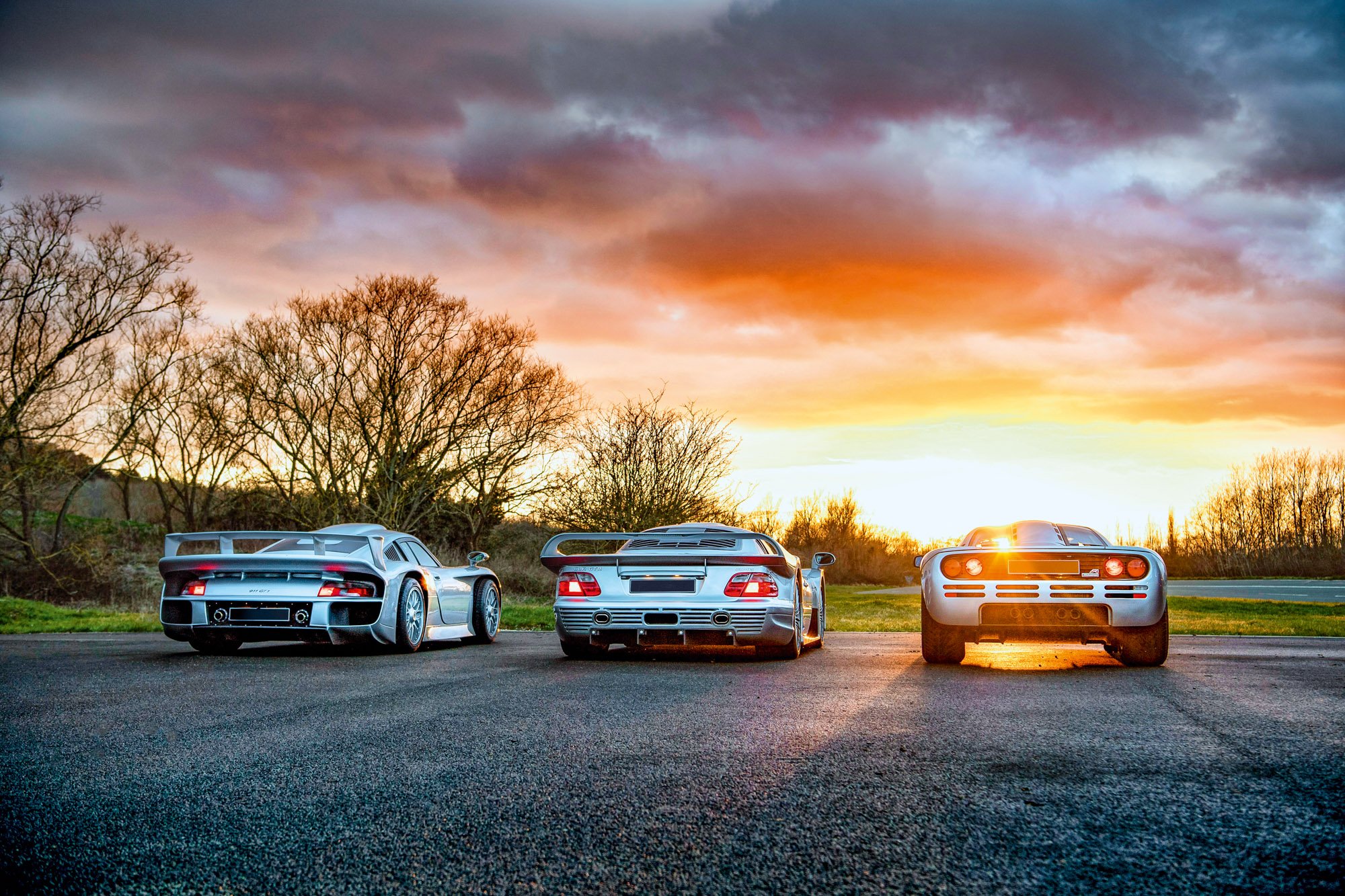 – THANKS TO DK Engineering, dkeng.co.uk, and the cars’ owners.
– THANKS TO DK Engineering, dkeng.co.uk, and the cars’ owners.


